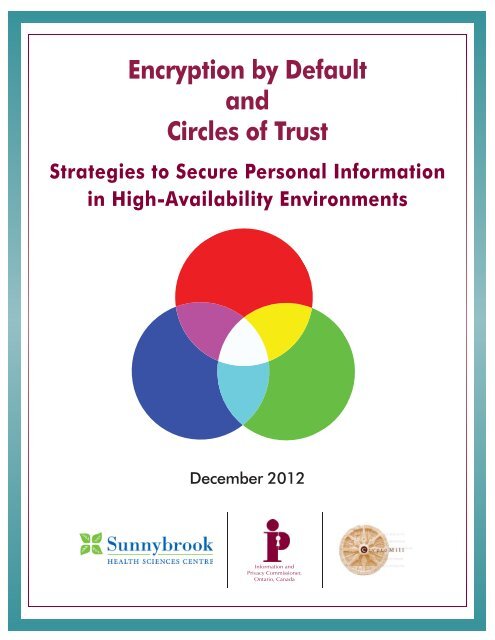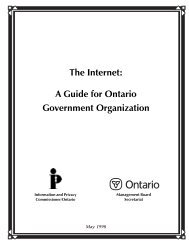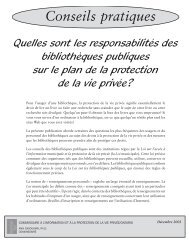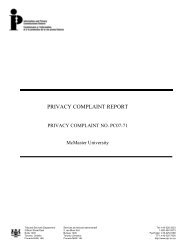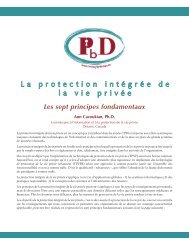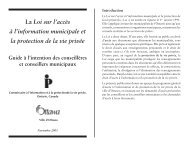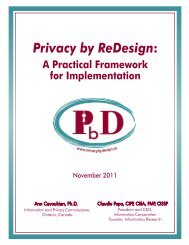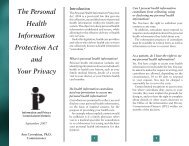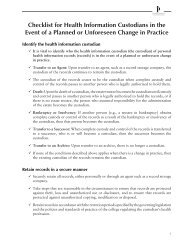Encryption by Default and Circles of Trust: Strategies to Secure ...
Encryption by Default and Circles of Trust: Strategies to Secure ...
Encryption by Default and Circles of Trust: Strategies to Secure ...
Create successful ePaper yourself
Turn your PDF publications into a flip-book with our unique Google optimized e-Paper software.
<strong>Encryption</strong> <strong>by</strong> <strong>Default</strong><br />
<strong>and</strong><br />
<strong>Circles</strong> <strong>of</strong> <strong>Trust</strong><br />
<strong>Strategies</strong> <strong>to</strong> <strong>Secure</strong> Personal Information<br />
in High-Availability Environments<br />
December 2012<br />
Information <strong>and</strong><br />
Privacy Commissioner,<br />
Ontario, Canada
Acknowledgements<br />
I gratefully acknowledge the contributions <strong>of</strong>: Jeff Curtis, MBA,<br />
MSc, CISSP, CISM, Chief Privacy Officer, Sunnybrook Health<br />
Sciences Centre; N<strong>and</strong>ini Jolly, President <strong>and</strong> Chief Executive<br />
Officer, Cryp<strong>to</strong>Mill Technologies Ltd <strong>and</strong> Privacy <strong>by</strong> Design (PbD)<br />
Ambassador; Fred Carter, Senior Policy <strong>and</strong> Technology Advisor, <strong>and</strong><br />
Michelle Chibba, Direc<strong>to</strong>r <strong>of</strong> Policy, Office <strong>of</strong> the Information <strong>and</strong><br />
Privacy Commissioner <strong>of</strong> Ontario, Canada, in the preparation <strong>of</strong> this<br />
paper. I would also like <strong>to</strong> thank Sam Marafioti, Chief Information<br />
Officer, Sunnybrook Health Sciences Centre, for his leadership <strong>and</strong><br />
support for this project.<br />
Ann Cavoukian, Ph.D.<br />
Ann Cavoukian, Ph.D.<br />
Commissioner<br />
Information <strong>and</strong> Privacy Commissioner<br />
Ontario, Canada<br />
2 Bloor Street East<br />
Suite 1400<br />
Toron<strong>to</strong>, Ontario<br />
M4W 1A8<br />
Canada<br />
416-326-3333<br />
1-800-387-0073<br />
Fax: 416-325-9195<br />
TTY (Teletypewriter): 416-325-7539<br />
Website: www.ipc.on.ca<br />
Privacy <strong>by</strong> Design: www.privacy<strong>by</strong>design.ca
TABLE OF CONTENTS<br />
Overview ............................................................................. 1<br />
1.0 End-<strong>to</strong>-End Security ........................................................ 2<br />
2.0 Health-Care Security Challenges .................................... 3<br />
2.1 Sunnybrook’s End-<strong>to</strong>-End Security Challenge ............................3<br />
2.2 <strong>Encryption</strong> ...............................................................................4<br />
2.3 Mobile Device <strong>Encryption</strong> ........................................................5<br />
2.4 An Overview <strong>of</strong> Sunnybrook’s Mobile <strong>Encryption</strong> Strategy ..........6<br />
3.0 Using Technology for Better Risk Management ................. 8<br />
3.1 Cryp<strong>to</strong>Mill <strong>Trust</strong> Boundaries <strong>and</strong> <strong>Circles</strong> <strong>of</strong> <strong>Trust</strong> ........................8<br />
3.2 Desirable Security Properties <strong>of</strong> <strong>Trust</strong> Boundaries ......................9<br />
3.3 The PHIPA Circle <strong>of</strong> Care .......................................................10<br />
4.0 Illustrative Deployment Scenarios ................................... 11<br />
5.0 Conclusions ................................................................. 13<br />
6.0 References .................................................................... 14<br />
6.1 Selected Information Resources .............................................14
Overview<br />
This paper discusses the challenges <strong>of</strong> assuring strong security <strong>of</strong> sensitive personal<br />
health information (PHI) s<strong>to</strong>red on portable s<strong>to</strong>rage media <strong>by</strong> organizations that<br />
require high data availability <strong>and</strong> use. The loss or theft <strong>of</strong> unencrypted mobile<br />
computing devices or s<strong>to</strong>rage media remains the No. 1 cause <strong>of</strong> breaches – 53<br />
per cent <strong>of</strong> all U.S. health-care breaches reported since 2009. 1<br />
<strong>Encryption</strong> <strong>by</strong> default is the obvious solution. The power <strong>of</strong> the default cannot<br />
be over-estimated – the default rules! But encryption <strong>by</strong> default is not always<br />
easy <strong>to</strong> assure in large, complex health-care operating environments. Using the<br />
example <strong>of</strong> Sunnybrook Health Sciences Centre’s leadership <strong>and</strong> policies, the paper<br />
illustrates how the Privacy <strong>by</strong> Design (PbD) Principle <strong>of</strong> “End-<strong>to</strong>-End Security”<br />
can be applied proactively <strong>and</strong> systematically, <strong>to</strong> become embedded in design <strong>and</strong><br />
realize positive-sum results.<br />
The paper also introduces the “Circle <strong>of</strong> <strong>Trust</strong>” concept, developed <strong>by</strong> Cryp<strong>to</strong>Mill<br />
Technologies. Modelled after the “Circle <strong>of</strong> Care” concept, <strong>Circles</strong> <strong>of</strong> <strong>Trust</strong> refer <strong>to</strong><br />
mobile encryption deployment scenarios that enable the free flow <strong>of</strong> PHI strictly<br />
among authorized health-care providers, only for purposes <strong>of</strong> patient-care <strong>and</strong><br />
treatment, while at the same time, ensuring that PHI remains encrypted <strong>and</strong><br />
inaccessible <strong>to</strong> anyone else, <strong>by</strong> default.<br />
This paper targets information management pr<strong>of</strong>essionals <strong>and</strong> is intended <strong>to</strong><br />
illustrate evolving security approaches <strong>and</strong> practices, with the help <strong>of</strong> two community<br />
partners: Sunnybrook Health Sciences Centre <strong>and</strong> Cryp<strong>to</strong>Mill Technologies. This<br />
paper explores the end-point encryption practices in place or being considered<br />
<strong>by</strong> Sunnybrook <strong>and</strong> provides an overview <strong>of</strong> emerging access control technology<br />
that can be applied within large-scale enterprise environments.<br />
Together, we hope this paper stimulates discussion regarding the challenges <strong>and</strong><br />
opportunities for ensuring the security <strong>of</strong> personal health information within<br />
health-care settings, <strong>and</strong> beyond.<br />
1 According <strong>to</strong> the <strong>of</strong>ficial breach tally from the U.S. Department <strong>of</strong> Health <strong>and</strong> Human Services’ Office for<br />
Civil Rights: http://1.usa.gov/a2UGEG<br />
1
1.0 End-<strong>to</strong>-End Security<br />
Data security is essential <strong>to</strong> information privacy. Indeed, without security, there<br />
can be no privacy. The Privacy <strong>by</strong> Design principle “End-<strong>to</strong>-End Security – Full<br />
Lifecycle Protection” seeks the highest st<strong>and</strong>ard <strong>of</strong> data security possible. 2<br />
Personal data should be au<strong>to</strong>matically <strong>and</strong> continuously protected, i.e., secure,<br />
during all stages <strong>of</strong> collection, use <strong>and</strong> disclosure, <strong>and</strong> during retention <strong>and</strong><br />
destruction. Personal data should be protected <strong>by</strong> default (au<strong>to</strong>matically) wherever<br />
<strong>and</strong> however it travels or resides – in a mobile device, in a corporate database, or<br />
in the Cloud – there should be no gaps in protection or accountability for secure<br />
s<strong>to</strong>rage or transmission. Thus, PbD ensures cradle-<strong>to</strong>-grave, secure lifecycle<br />
management <strong>of</strong> personal information, from end-<strong>to</strong>-end.<br />
Assuring full lifecycle protection is a significant challenge for organizations<br />
<strong>to</strong>day because their operations have become more data-intensive, more networkdependent,<br />
<strong>and</strong> more accessible than ever before. The explosion in the use <strong>of</strong> mobile<br />
devices such as lap<strong>to</strong>ps, smartphones, tablets, USB drives, <strong>and</strong> portable s<strong>to</strong>rage<br />
media, as well as the increasing use <strong>of</strong> personal mobile devices for business use,<br />
are causing a fundamental rethink <strong>of</strong> how best <strong>to</strong> protect the modern enterprise’s<br />
sensitive data from “end-<strong>to</strong>-end.”<br />
As data processing technologies, business practices, <strong>and</strong> networked architectures<br />
become more complex <strong>and</strong> critical for operations, it is more important than ever <strong>to</strong><br />
anticipate security risks as early as possible, <strong>and</strong> <strong>to</strong> mitigate those risks <strong>by</strong> building<br />
strong technical, administrative, <strong>and</strong> physical security practices right in<strong>to</strong> the<br />
architecture <strong>and</strong> way <strong>of</strong> doing business, <strong>by</strong> default. The strength <strong>and</strong> convenience <strong>of</strong><br />
security <strong>by</strong> default also supports PbD Principle #2: “Privacy as the <strong>Default</strong> Setting.”<br />
The health-care sec<strong>to</strong>r is a particularly challenging area in which <strong>to</strong> deploy security<br />
controls for a number <strong>of</strong> reasons (discussed in the next section), but especially<br />
because <strong>of</strong> operational requirements for high availability <strong>and</strong> integrity <strong>of</strong> sensitive<br />
personal health information (PHI) used for patient care <strong>and</strong> treatment, research,<br />
<strong>and</strong> teaching purposes. In health-care settings, patients expect strong security<br />
<strong>and</strong> robust access control mechanisms <strong>to</strong> be in place. These expectations are<br />
supported <strong>by</strong> evolving legal <strong>and</strong> regula<strong>to</strong>ry responsibilities governing the security<br />
<strong>of</strong> data h<strong>and</strong>ling practices, transparency <strong>of</strong> operations, <strong>and</strong> breach notification<br />
requirements. 3 A large, decentralized hospital complex, for example, will have special<br />
challenges <strong>to</strong> ensure end-<strong>to</strong>-end protection <strong>of</strong> sensitive data in an environment<br />
characterized <strong>by</strong> legacy systems, increasing interoperability, <strong>and</strong> 24/7 dem<strong>and</strong>s<br />
for access <strong>to</strong> accurate, up-<strong>to</strong>-date PHI for care purposes. These challenges are<br />
representative <strong>of</strong> an evolving l<strong>and</strong>scape requiring both data availability <strong>and</strong> data<br />
protection on a large scale. 4<br />
2 See full set <strong>of</strong> 7 Privacy <strong>by</strong> Design Foundational Principles at www.privacy<strong>by</strong>design.ca<br />
3 For a discussion <strong>of</strong> health-care breach costs <strong>and</strong> incentives, see, The Financial Impact <strong>of</strong> Breached Protected<br />
Health Information: A Business Case for Enhanced Security (2012) at http://webs<strong>to</strong>re.ansi.org/phi<br />
4 For a discussion <strong>of</strong> how applied privacy can strengthen organizational security, see Ann<br />
Cavoukian. (2005) Identity Theft Revisited: Security is Not Enough, at: http://bit.ly/eAuxg1<br />
See also the following guidance on applying a “Privacy <strong>by</strong> ReDesign” approach <strong>to</strong> legacy systems: Cavoukian<br />
<strong>and</strong> Prosch, Privacy <strong>by</strong> ReDesign: Building a Better Legacy, at http://bit.ly/S2xT27 <strong>and</strong> Cavoukian <strong>and</strong> Popa,<br />
(2011) Privacy <strong>by</strong> ReDesign: A Practical Framework for Implementation, at: http://bit.ly/OMcuoW<br />
2
2.0 Health-Care Security Challenges<br />
As oversight authority for the Personal Health Information Privacy Act, 2004<br />
(PHIPA), the Office <strong>of</strong> the Information <strong>and</strong> Privacy Commissioner <strong>of</strong> Ontario,<br />
Canada (IPC) recognizes the challenges <strong>of</strong> providing strong privacy <strong>and</strong> security<br />
protection for PHI.<br />
Large health-care institutions face security pressures due <strong>to</strong> the following:<br />
• High dem<strong>and</strong> for, <strong>and</strong> ease <strong>of</strong> accessibility <strong>to</strong>, personal data;<br />
• Large numbers <strong>of</strong> authorized internal <strong>and</strong>, increasingly, external users who<br />
form the patient’s Circle <strong>of</strong> Care;<br />
• Increasing interoperability (<strong>and</strong> an associated increase in privacy <strong>and</strong> security)<br />
st<strong>and</strong>ards within regional shared systems <strong>and</strong> across provincial jurisdictions;<br />
• Increased dem<strong>and</strong> for <strong>and</strong> the need for rapid adoption <strong>of</strong> new information<br />
management technologies at the point <strong>of</strong> care (e.g. wireless networking, RFID,<br />
a ubiqui<strong>to</strong>us electronic medical record) that do not in themselves provide<br />
secure sharing <strong>of</strong> information between users, devices, organizations, <strong>and</strong><br />
government bodies;<br />
• Increased complexity in the health-care IT support model due <strong>to</strong> all <strong>of</strong> the<br />
above, which results in an increased potential for technology configuration<br />
<strong>and</strong> management errors; <strong>and</strong><br />
• Increased strain on IT budgets <strong>and</strong> resources, including an increasing need for<br />
comprehensive security policy, procedures, <strong>and</strong> trained information security<br />
personnel, <strong>and</strong> especially including security-aware end-users.<br />
2.1 Sunnybrook’s End-<strong>to</strong>-End Security Challenge<br />
Sunnybrook’s information assets are, similar <strong>to</strong> all health-care institutions,<br />
vulnerable <strong>to</strong> loss or theft, facing a number <strong>of</strong> threats potentially affecting the<br />
confidentiality, integrity, or availability <strong>of</strong> these assets, including risks <strong>to</strong> the<br />
confidentiality <strong>of</strong> personal information <strong>and</strong> personal health information <strong>of</strong> staff,<br />
patients, <strong>and</strong> partners, <strong>and</strong> the privacy rights <strong>of</strong> the individuals affected <strong>by</strong> data<br />
loss. Insider <strong>and</strong> external threats leading <strong>to</strong> data loss or theft exist across all<br />
clinical <strong>and</strong> administrative activities involving data h<strong>and</strong>ling <strong>by</strong> Sunnybrook staff,<br />
partners, <strong>and</strong> patients.<br />
Effective lifecycle management <strong>of</strong> data, therefore, requires a structured <strong>and</strong><br />
st<strong>and</strong>ards-based approach <strong>to</strong> information risk management <strong>and</strong> should be<br />
composed <strong>of</strong> a core set <strong>of</strong> IT governance objectives addressing data loss prevention.<br />
Administrative (policy <strong>and</strong> procedure) <strong>and</strong> technical (logical <strong>and</strong> physical)<br />
security controls appropriate in these circumstances are required <strong>to</strong> reduce <strong>and</strong><br />
manage risks <strong>to</strong> an acceptable level, which supports Sunnybrook’s information<br />
3
management objectives. Data loss prevention controls ideally cover the complete<br />
range <strong>of</strong> corporate activities <strong>and</strong> threat scenarios associated with data collection,<br />
s<strong>to</strong>rage <strong>and</strong> use, data transfer, <strong>and</strong> disclosure (i.e. transfer within Sunnybrook<br />
<strong>and</strong> between Sunnybrook <strong>and</strong> its partners, peers, <strong>and</strong> patients), <strong>and</strong> data retention<br />
<strong>and</strong> destruction (<strong>and</strong> especially during the decommissioning <strong>of</strong> portable computing<br />
devices). Controls must address data at rest, data in motion, or data in use within<br />
each <strong>of</strong> these information lifecycle activity areas.<br />
2.2 <strong>Encryption</strong><br />
<strong>Encryption</strong> technology <strong>and</strong> management are subsets <strong>of</strong> available security controls,<br />
which directly address the potential for confidential data loss or theft <strong>and</strong> should<br />
be applied <strong>to</strong> both data at rest (s<strong>to</strong>red on media) <strong>and</strong> data in motion (during<br />
transmission over networks or during mobile device transport). For example,<br />
encryption controls should be applied during the transmission <strong>of</strong> data over<br />
otherwise unsecure networks (e.g. the Internet) <strong>by</strong> encrypting the data being<br />
transmitted <strong>and</strong>, ideally, <strong>by</strong> establishing a secure data transmission session<br />
between the sender <strong>and</strong> receiver. Data transmission security can be achieved <strong>by</strong><br />
encrypting the data exchanged between the sender <strong>and</strong> receiver with or without<br />
securing the network connection or transmission session itself, with the parties<br />
either manually or au<strong>to</strong>matically exchanging a decryption key using another<br />
secure channel (e.g. encrypting email before sending over the open Internet using<br />
a prearranged password or other decryption key).<br />
Data at rest can be encrypted either at the file, folder, or whole disk level at the<br />
time the data is s<strong>to</strong>red, <strong>and</strong> the data should remain encrypted until accessed <strong>by</strong><br />
someone who possesses the authorization <strong>to</strong> access <strong>and</strong> decrypt the information. In<br />
practice, there is a need for balance between usability <strong>and</strong> security <strong>and</strong> encryption<br />
controls are no exception. In many institutional settings, for example, users may<br />
be able (conveniently) <strong>to</strong> use their system logon ID <strong>and</strong> password <strong>to</strong> act as the<br />
effective decryption key (or as credentials for au<strong>to</strong>matic access <strong>to</strong> a separately<br />
s<strong>to</strong>red key) when logging on<strong>to</strong> a personally assigned lap<strong>to</strong>p. On the other h<strong>and</strong>,<br />
single fac<strong>to</strong>r (i.e. password only) logon schemes such as these typically employ<br />
a compensating lock-out feature if logon attempts exceed a preset threshold in<br />
order <strong>to</strong> (slightly) reduce the chance <strong>of</strong> unauthorized access attempts through<br />
password guessing. If logon is successful, the data remains accessible throughout<br />
the user session until the session is logged <strong>of</strong>f or the lap<strong>to</strong>p is shut down. In<br />
these common use scenarios, caution must be exercised <strong>by</strong> the user <strong>to</strong> ensure<br />
that the device is not lost during the logged on session where the data may be<br />
available <strong>to</strong> anyone with physical access <strong>to</strong> the device. Potential loss <strong>of</strong> data in<br />
this scenario can be further mitigated, therefore, <strong>by</strong> the use <strong>of</strong> an appropriate<br />
time out device (e.g. a password protected screen saver) which locks the device<br />
after a preset time <strong>of</strong> inactivity, <strong>and</strong> requires user authentication <strong>to</strong> re-establish<br />
the session <strong>and</strong> also gain access <strong>to</strong> otherwise encrypted data.<br />
4
<strong>Encryption</strong> solutions (whether for data in motion or data at rest) can be applied<br />
either as an enterprise “end point protection” (EPP) or “data loss protection” (DLP)<br />
solution (e.g. as part <strong>of</strong> a centralized security policy enforcement suite, which<br />
may also include port <strong>and</strong> plug-in device control with au<strong>to</strong>-encryption options)<br />
or as a st<strong>and</strong>-alone end point solution applied on a case-<strong>by</strong>-case basis, possibly<br />
at the discretion <strong>of</strong> the data or system owner, one data set, device, or service at<br />
a time. Email encryption, for example, can be applied using either centralized,<br />
multi-institution services such as eHealth Ontario’s ONE Mail service 5 (now<br />
available <strong>to</strong> most Ontario hospitals) or <strong>by</strong> engaging a commercial service provider<br />
for cus<strong>to</strong>m email encryption solutions, typically requiring each email recipient <strong>to</strong><br />
register themselves with the service the first time they receive encrypted email. The<br />
usability <strong>and</strong> convenience <strong>to</strong> both the sender <strong>and</strong> the recipient in using this type<br />
<strong>of</strong> service is <strong>of</strong>ten a strong fac<strong>to</strong>r in the balancing <strong>of</strong> considerations for selection,<br />
deployment, <strong>and</strong> management <strong>of</strong> specific encryption solutions <strong>by</strong> an institution.<br />
2.3 Mobile Device <strong>Encryption</strong><br />
S<strong>to</strong>rage <strong>of</strong> data on an unencrypted mobile computing device such as a lap<strong>to</strong>p,<br />
USB key or portable drive, or a smartphone presents an inherent vulnerability <strong>to</strong><br />
physical loss or theft <strong>and</strong> so the data needs <strong>to</strong> be protected from inappropriate<br />
access, should the device itself go missing. The proliferation <strong>and</strong> the diversity<br />
<strong>of</strong> these devices (many <strong>of</strong> which are, increasingly, not corporately provisioned<br />
but are originally personal devices, <strong>and</strong> which continue <strong>to</strong> be used as personal<br />
devices at work) has also increased the need for comprehensive security <strong>of</strong> the<br />
data accessible on or through these devices.<br />
When assessing the likelihood <strong>of</strong> data loss due <strong>to</strong> a lost or s<strong>to</strong>len mobile device,<br />
the key privacy compliance issue is that, without prior knowledge <strong>of</strong> or control over<br />
what data goes on<strong>to</strong> a device, a health information cus<strong>to</strong>dian cannot unfortunately,<br />
rely solely on the goodwill or discretion <strong>of</strong> the user as <strong>to</strong> what he or she s<strong>to</strong>res<br />
on the device or <strong>to</strong> determine whether the device should be encrypted <strong>to</strong> protect<br />
confidential data. Users may be either unaware <strong>of</strong> the data actually s<strong>to</strong>red on the<br />
device at the time <strong>of</strong> loss, or may simply underestimate the nature or extent <strong>of</strong><br />
data actually at risk. Sunnybrook’s default risk position is, therefore, <strong>to</strong> assume<br />
confidential data assets are, in fact, s<strong>to</strong>red on each mobile device <strong>and</strong> therefore,<br />
each device must be encrypted in order <strong>to</strong> ensure that the risk <strong>of</strong> data loss is<br />
absolutely minimized should any device actually go missing. Deployment <strong>and</strong><br />
support implications for such a comprehensive strategy entails that all portable<br />
devices used for Sunnybrook business purposes must be demonstrably encrypted<br />
at all times, whether they contain PHI or not.<br />
The diversity <strong>of</strong> mobile devices, which are increasingly personally provisioned<br />
for Sunnybrook’s business purposes, the need for legal <strong>and</strong> policy compliance<br />
assurance, <strong>and</strong> the need <strong>to</strong> avoid disruption <strong>to</strong> the availability <strong>of</strong>, or loss <strong>of</strong>, nonrecoverable<br />
Sunnybrook data, therefore means that mobile encryption is here<br />
5 www.ehealthontario.on.ca/en/services/one-mail<br />
5
<strong>to</strong> stay, even if the provisioning <strong>of</strong> universally reliable, convenient, <strong>and</strong> secure<br />
remote access solutions becomes available for most use cases. Implementing a<br />
comprehensive but flexible mobile device encryption strategy across all possible<br />
use scenarios is the key theme <strong>of</strong> this paper.<br />
2.4 An Overview <strong>of</strong> Sunnybrook’s Mobile <strong>Encryption</strong> Strategy<br />
There are a number <strong>of</strong> recognized best practices for identifying data at risk<br />
<strong>and</strong> for selecting appropriate mobile encryption controls <strong>to</strong> prevent data loss.<br />
Sunnybrook’s Information Services group is actively involved in the following data<br />
loss risk management activities, which are expected <strong>to</strong> lower data loss exposure<br />
<strong>and</strong> contribute <strong>to</strong> a comprehensive data loss management strategy over time.<br />
As a matter <strong>of</strong> best practice for data lifecycle risk management, Sunnybrook is<br />
fundamentally ensuring that it is following a systematic information security<br />
program for data loss protection across the lifecycle <strong>of</strong> collection, use, transmission/<br />
disclosure, retention, <strong>and</strong> destruction, with a focus on appropriate encryption<br />
for data in motion <strong>and</strong> data at rest, where required. Mobile devices <strong>and</strong> lap<strong>to</strong>ps,<br />
in particular, are encrypted on first admission <strong>to</strong> Sunnybrook’s network (even if<br />
presented as a personal device) or prior <strong>to</strong> deployment (if corporately provisioned)<br />
<strong>to</strong> ensure that the device is either adequately encrypted before use for Sunnybrook<br />
business purposes or is refused access <strong>to</strong> the corporate network or other corporate<br />
computing services. <strong>Encryption</strong> is thereafter moni<strong>to</strong>red as part <strong>of</strong> a comprehensive<br />
set <strong>of</strong> device compliance checks including, for example, corporate policy based<br />
anti-virus management.<br />
To accomplish a risk-managed approach for data loss protection, <strong>and</strong> particularly<br />
for the risk-based selection <strong>of</strong> encryption policy, procedure <strong>and</strong> technology controls,<br />
Sunnybrook is following best practices for identifying data <strong>and</strong> devices at risk<br />
<strong>and</strong> implementing controls that are appropriate for the associated risk pr<strong>of</strong>ile<br />
<strong>and</strong> for management’s corresponding risk <strong>to</strong>lerance <strong>and</strong> appetite.<br />
These practices include:<br />
1. Determining what data is most sensitive <strong>and</strong> where it resides. Sunnybrook<br />
is completing a data asset discovery, classification, <strong>and</strong> inven<strong>to</strong>ry which<br />
identifies <strong>and</strong> prioritizes data assets which are created within the enterprise,<br />
enter via network boundaries (e.g. via the Web, email or partner interface) or<br />
are physically transported via portable media (lap<strong>to</strong>ps, smartphones, USB<br />
devices). As a matter <strong>of</strong> best practice, identification <strong>of</strong> data in the institution’s<br />
cus<strong>to</strong>dy <strong>and</strong> control is always the first step <strong>to</strong>wards accountability over<br />
potential theft or loss.<br />
2. Underst<strong>and</strong>ing the origin <strong>and</strong> nature <strong>of</strong> data loss risks. Sunnybrook<br />
Information Services undertakes both privacy impact <strong>and</strong> security threat<br />
risk assessments <strong>of</strong> the most likely scenarios constituting loss <strong>of</strong> data<br />
assets <strong>and</strong> services, based on identified system, application, <strong>and</strong> database<br />
vulnerabilities, threat likelihood estimates <strong>and</strong> asset sensitivity <strong>and</strong> exposure.<br />
6
These reviews are intended <strong>to</strong> reveal priority areas for risk remediation, <strong>and</strong><br />
contribute directly <strong>to</strong> Sunnybrook’s emerging IT Governance Program <strong>and</strong><br />
overall information security posture.<br />
3. Selecting appropriate information management controls based on policy<br />
goals, risk objectives, <strong>and</strong> the location <strong>and</strong> use <strong>of</strong> sensitive data. Healthcare<br />
institutions, like any other data cus<strong>to</strong>dians, cannot afford <strong>to</strong> mitigate<br />
all data loss risks at once, <strong>and</strong> should, therefore, choose controls that are<br />
commensurate with the risk level presented, conditioned <strong>by</strong> management’s<br />
risk <strong>to</strong>lerance (variability <strong>of</strong> outcome) <strong>and</strong> appetite (absolute loss aversion).<br />
From a legal compliance <strong>and</strong> ubiquity <strong>of</strong> use perspective, mobile device<br />
encryption (<strong>and</strong> the associated asset management <strong>and</strong> network security<br />
supports) represents a key area for continued Sunnybrook integration with<br />
enterprise security management policies, <strong>to</strong>ols, <strong>and</strong> processes.<br />
4. Managing security centrally. Sunnybrook continuously evaluates the<br />
deployment, usability, <strong>and</strong> support success <strong>of</strong> encryption technologies which<br />
are susceptible <strong>to</strong> the risk <strong>of</strong> policy misalignment, increasing management<br />
costs, <strong>and</strong> user complacency, over the lifecycle <strong>of</strong> the affected data assets,<br />
devices, <strong>and</strong> evolving user needs. Opportunities for increased integration<br />
<strong>of</strong> encryption technologies, key management across platforms <strong>and</strong> devices,<br />
<strong>and</strong> compliance moni<strong>to</strong>ring <strong>and</strong> auditing are being constantly re-evaluated<br />
<strong>to</strong> take advantage <strong>of</strong> improvements in centralized asset <strong>and</strong> network access<br />
management, policy maturity improvements <strong>and</strong> orchestration, <strong>and</strong> improved<br />
platform, application <strong>and</strong> database hardening based on risk priority, where<br />
appropriate. The diversity <strong>of</strong> needs <strong>and</strong> devices, coupled with innovations<br />
in the core supporting technologies, means a move <strong>to</strong> increased end-point<br />
security flexibility with greater centralized visibility <strong>and</strong> control over data<br />
loss risk pr<strong>of</strong>ile over time.<br />
5. Auditing security performance for constant improvement. In conjunction<br />
with an emerging IT Governance program based on the COBIT 6 process<br />
control framework, Sunnybrook is improving its moni<strong>to</strong>ring <strong>of</strong> security<br />
functions which support data loss prevention, including remote moni<strong>to</strong>ring<br />
<strong>and</strong> management <strong>of</strong> encrypted devices, <strong>and</strong> is increasingly putting in<strong>to</strong><br />
place end-user accountabilities for the protection <strong>of</strong> data assets at all levels<br />
<strong>of</strong> system, application, device <strong>and</strong> database ownership. Formalized <strong>and</strong><br />
consistent accountabilities for risk-based incident investigation, management<br />
reporting, correlation <strong>of</strong> security related incidents, <strong>and</strong> auditing <strong>and</strong><br />
enforcement <strong>of</strong> data security policy compliance supports <strong>and</strong> strengthens<br />
data loss risk pr<strong>of</strong>ile <strong>and</strong> is expected <strong>to</strong> result in greater compliance with<br />
privacy regulations <strong>and</strong> best practice st<strong>and</strong>ards over time.<br />
6 www.isaca.com/cobit<br />
7
3.0 Using Technology for Better Risk Management<br />
So far, we have described organization-wide policy <strong>and</strong> administrative options<br />
for securing PHI on mobile devices against loss or theft. Proactive leadership,<br />
expressed <strong>by</strong> systematic security methods, are consistent with Privacy <strong>by</strong> Design’s<br />
emphasis on holistic, embedded, <strong>and</strong> verifiable approaches <strong>to</strong> privacy <strong>and</strong> security.<br />
Regardless <strong>of</strong> how it is deployed in operation, m<strong>and</strong>ating encryption <strong>by</strong> default<br />
goes a long way <strong>to</strong>wards meeting the challenges <strong>of</strong> securing an organization’s<br />
exp<strong>and</strong>ing perimeters, <strong>and</strong> for achieving compliance objectives.<br />
There are, however, opportunities <strong>to</strong> improve upon the binary distinction between<br />
“inside” <strong>and</strong> “outside” an organization’s security perimeter, <strong>and</strong> between all-or-nothing<br />
access <strong>to</strong> encrypted PHI. Innovative new approaches <strong>to</strong> securing PHI on mobile devices<br />
can enable new functionalities <strong>and</strong> benefits, such as enabling selective access controls<br />
<strong>to</strong> help protect PHI against the risk <strong>of</strong> unauthorized access <strong>by</strong> insiders.<br />
3.1 Cryp<strong>to</strong>Mill <strong>Trust</strong> Boundaries <strong>and</strong> <strong>Circles</strong> <strong>of</strong> <strong>Trust</strong><br />
A <strong>Trust</strong> Boundary (TB) is a novel security mechanism introduced <strong>by</strong> Cryp<strong>to</strong>Mill<br />
Technologies that provides data containment <strong>by</strong> binding specified data <strong>to</strong> a<br />
defined group <strong>of</strong> users (generally, an organization or a subgroup therein). Using<br />
Cryp<strong>to</strong>Mill’s Zero Overhead Key Management technology in conjunction with their<br />
Intelligent Port Control, organizations can prevent the decryption <strong>of</strong> sensitive data<br />
outside <strong>of</strong> the <strong>Trust</strong> Boundary. Since the protected data is strongly encrypted,<br />
it is completely inaccessible for any user outside <strong>of</strong> the defined <strong>Trust</strong> Boundary,<br />
but fully <strong>and</strong> readily accessible for those users within the TB.<br />
8
Applying the <strong>Trust</strong> Boundary technology leads <strong>to</strong> the creation <strong>of</strong> a Circle <strong>of</strong> <strong>Trust</strong>.<br />
<strong>Circles</strong> <strong>of</strong> <strong>Trust</strong> become a means <strong>by</strong> which information s<strong>to</strong>red on mobile devices<br />
is made readily available <strong>to</strong> authorized parties “inside the circle” (the trusted<br />
parties), while remaining protected from, <strong>and</strong> inaccessible <strong>to</strong>, external parties.<br />
Importantly, collection, use, <strong>and</strong> disclosure rules are formally defined for both<br />
internal <strong>and</strong> external parties as a whole, such that access rights need not be<br />
managed for each possible data recipient or potential information use case. The<br />
concept <strong>of</strong> a Circle <strong>of</strong> <strong>Trust</strong> shares commonalities with the Circle <strong>of</strong> Care concept,<br />
applicable within health care for the management <strong>of</strong> personal health information,<br />
<strong>and</strong> is, therefore, another means <strong>of</strong> enforcing access rights <strong>and</strong> improving data<br />
loss prevention within otherwise high availability environments.<br />
3.2 Desirable Security Properties <strong>of</strong> <strong>Trust</strong> Boundaries<br />
The <strong>Trust</strong> Boundaries concept <strong>of</strong>fers the following desirable properties when<br />
applied <strong>to</strong> portable s<strong>to</strong>rage devices:<br />
• Data Protection through Intelligent Port Control: In the context <strong>of</strong><br />
encryption, port control ensures that any portable s<strong>to</strong>rage device plugged in<strong>to</strong><br />
a corporate workstation is first encrypted prior <strong>to</strong> permitting data <strong>to</strong> be copied<br />
on<strong>to</strong> the device. From a security perspective, this ensures that every portable<br />
s<strong>to</strong>rage device in use is encrypted, reducing or eliminating the security risks<br />
due <strong>to</strong> the transfer <strong>of</strong> data <strong>to</strong> an unencrypted mobile device. Intelligent Port<br />
Control ensures that the encryption is only applied <strong>to</strong> specified device types<br />
– an important deployment <strong>and</strong> support consideration in environments (such<br />
as Health Care) which continue <strong>to</strong> rely on USB connectivity for many devices<br />
other than portable s<strong>to</strong>rage.<br />
• <strong>Circles</strong> <strong>of</strong> <strong>Trust</strong>: In contrast <strong>to</strong> st<strong>and</strong>-alone encryption schemes, which<br />
typically restrict the use <strong>of</strong> the encrypted device <strong>to</strong> a single individual, the<br />
<strong>Trust</strong> Boundary can be exp<strong>and</strong>ed <strong>to</strong> multiple users or groups who may need<br />
access <strong>to</strong> the information after it has been transferred <strong>to</strong> the portable media.<br />
This reduces the proliferation <strong>of</strong> portable s<strong>to</strong>rage devices, since devices can<br />
be shared <strong>and</strong> reused <strong>by</strong> members <strong>of</strong> the Circle with the membership able<br />
<strong>to</strong> be (re)defined dynamically <strong>and</strong> centrally managed.<br />
• Easy Group Sharing: The au<strong>to</strong>mated encryption <strong>and</strong> decryption key<br />
management service allows for simple access <strong>to</strong> data <strong>by</strong> authorized individuals,<br />
without requiring passwords or otherwise increasing the accessing party’s<br />
burden. As a matter <strong>of</strong> user-centered design, this improves the usability <strong>of</strong> the<br />
security feature <strong>and</strong> therefore directly supports Privacy <strong>by</strong> Design principles.<br />
◦ Prevention <strong>of</strong> Internal Breaches: Curious (or malicious) individuals<br />
outside <strong>of</strong> the <strong>Trust</strong> Boundary cannot access the data on the device, even<br />
if THAT person has the Cryp<strong>to</strong>Mill s<strong>of</strong>tware installed <strong>and</strong> has access <strong>to</strong><br />
other (different) <strong>Trust</strong> Boundaries within their organization. In this way,<br />
data cannot be removed from the <strong>Trust</strong> Boundary, as it cannot be decrypted<br />
9
on computers or <strong>by</strong> people outside <strong>of</strong> it. This feature is explained further<br />
in Section 4 below. 7<br />
This makes the <strong>Trust</strong> Boundary a positive-sum solution, in that it increases both<br />
data security (against unauthorized use or access) while increasing availability <strong>to</strong><br />
authorized users. Further, it makes the <strong>Trust</strong> Boundary an intriguing platform<br />
upon which the Circle <strong>of</strong> Care can be technologically implemented.<br />
3.3 The PHIPA Circle <strong>of</strong> Care<br />
Under Ontario’s PHIPA, it is recognized that in some cases the effective provision <strong>of</strong><br />
health care will require sharing an individual’s personal health information among<br />
multiple health information cus<strong>to</strong>dians (a family doc<strong>to</strong>r, pharmacist, hospital, etc.)<br />
without the need <strong>to</strong> obtain the patient’s express consent for each disclosure. To<br />
facilitate the transfer <strong>of</strong> PHI between health information cus<strong>to</strong>dians for the purpose<br />
<strong>of</strong> providing health care, the concept <strong>of</strong> the Circle <strong>of</strong> Care was developed. 8<br />
The act <strong>of</strong> sharing (disclosure) brings the new cus<strong>to</strong>dian in<strong>to</strong> the Circle <strong>of</strong> Care.<br />
Thus, from an information security perspective, a Circle <strong>of</strong> <strong>Trust</strong> – a set <strong>of</strong> authorized<br />
entities implicitly assigned data collection, use, <strong>and</strong> disclosure rights – is created.<br />
However, the means <strong>by</strong> which data remains accessible inside, but inaccessible<br />
outside, <strong>of</strong> the Circle <strong>of</strong> <strong>Trust</strong> remains undefined <strong>by</strong> the concept <strong>of</strong> Circle <strong>of</strong> Care.<br />
While this could be (<strong>and</strong> <strong>of</strong>ten is) implemented largely <strong>by</strong> policy <strong>and</strong> goodwill,<br />
from both a security <strong>and</strong> Privacy <strong>by</strong> Design perspective, it is preferable <strong>to</strong> build<br />
privacy protections in<strong>to</strong> both the data technology <strong>and</strong> sharing practices <strong>of</strong> such<br />
a system.<br />
Privacy <strong>by</strong> Design emphasizes that protections be built in<strong>to</strong> information technologies,<br />
business practices, physical design, <strong>and</strong> networked infrastructure, <strong>by</strong> default.<br />
Creating a Circle <strong>of</strong> <strong>Trust</strong> is no exception. While it is possible <strong>to</strong> implement such<br />
a system based on acceptable usage policies alone, the true strength <strong>of</strong> the Circle<br />
<strong>of</strong> <strong>Trust</strong> is only seen when embedded technological protections operate in concert<br />
with usage policies.<br />
7 Simple device encryption (without <strong>Trust</strong> Boundaries) covers situations where the device is lost or s<strong>to</strong>len.<br />
These are scenarios where the new “owner” <strong>of</strong> the physical device is completely unrelated <strong>to</strong> the original<br />
organization. Simple device encryption covers the “mishap” case – one which conscientious people try <strong>to</strong> guard<br />
against (loss/theft) <strong>and</strong> is therefore an exceptional circumstance. With <strong>Trust</strong> Boundary protection, however,<br />
data loss is prevented in more common scenarios where access <strong>to</strong> devices is <strong>by</strong> people who have a right <strong>to</strong><br />
be in the vicinity <strong>of</strong> the data, <strong>and</strong> who have rights <strong>to</strong> access data from other parts <strong>of</strong> the organization. USB<br />
s<strong>to</strong>rage devices borrowed <strong>by</strong> co-workers <strong>and</strong> other legitimate employees inside an organization are not typically<br />
considered <strong>to</strong> be lost or s<strong>to</strong>len. Yet, in these scenarios, it is easy for sensitive data <strong>to</strong> migrate in<strong>to</strong> the wrong<br />
h<strong>and</strong>s (intentionally, or accidentally). A third scenario, involving the need <strong>to</strong> access data on a protected USB<br />
drive from a foreign computer (for example, a presentation) would require a password-based solution.<br />
8 For a full discussion, see Ann Cavoukian. (2009) Circle <strong>of</strong> Care: Sharing Personal Health Information for<br />
Health-Care Purposes, at: http://bit.ly/R2Isep<br />
10
4.0 Illustrative Deployment Scenarios<br />
Taken collectively, the data protection features <strong>of</strong> “Intelligent Port Control” represent<br />
an innovative new positive-sum approach <strong>to</strong> solving the data in motion security<br />
concerns while enabling shared authorized access with removable s<strong>to</strong>rage devices.<br />
As noted above, this approach is distinctly different than traditional methods,<br />
which we refer <strong>to</strong> here as “Legacy Port Control.”<br />
1. Detection <strong>of</strong> S<strong>to</strong>rage Devices versus other USB Devices<br />
Intelligent Port Control specifically controls data s<strong>to</strong>rage devices, which<br />
include removable hard drives, USB flash drives, memory sticks, <strong>and</strong><br />
other portable s<strong>to</strong>rage media. Unlike some Legacy Port Control systems,<br />
this is not an “all-or-nothing” option: Intelligent Port Control leaves all<br />
other USB devices alone. USB equipment (e.g. mice, printers, scanners,<br />
or specialty medical equipment) are not controlled, <strong>and</strong> operate without<br />
interference.<br />
2. Au<strong>to</strong>matic Device Management<br />
Intelligent Port Control s<strong>to</strong>rage detection is au<strong>to</strong>matic – if the inserted device<br />
looks like a “s<strong>to</strong>rage-<strong>to</strong>-Windows” device, it will be controlled. A given device<br />
is considered “s<strong>to</strong>rage,” in this sense, if it implements a disk-like interface<br />
that presents a Windows-recognized block-oriented file system (such as<br />
FAT, FAT32, or NTFS). For such devices, Windows au<strong>to</strong>matically mounts<br />
the file system, <strong>and</strong> the device’s content is typically visible as files within<br />
Windows Explorer. Common examples <strong>of</strong> such s<strong>to</strong>rage devices abound,<br />
<strong>and</strong> include USB flash drives, removable USB, <strong>and</strong> FireWire (IEEE 1394)<br />
disks, SD cards, <strong>and</strong> memory sticks.<br />
Unlike some Legacy Port Control systems, there is no need <strong>to</strong> maintain<br />
white <strong>and</strong> black lists <strong>of</strong> Device ID’s, Vendor ID’s, <strong>and</strong> Device Model ID’s.<br />
Managing lists such as these is cumbersome, prone <strong>to</strong> error, security<br />
breaches, <strong>and</strong> annoying for end-users who have <strong>to</strong> wait for IT technicians<br />
<strong>to</strong> unblock their access <strong>to</strong> new removable media. It also eliminates the<br />
need for pre-encrypted or proprietary s<strong>to</strong>rage devices – any commonlyavailable,<br />
easily-purchasable device can be encrypted.<br />
3. Can use both Encrypted <strong>and</strong> Non Encrypted S<strong>to</strong>rage<br />
Intelligent Port Control differentiates between encrypted s<strong>to</strong>rage <strong>and</strong> nonencrypted<br />
s<strong>to</strong>rage, applying different policies for each. The control policies<br />
are set <strong>by</strong> the organization, <strong>and</strong> can be user <strong>and</strong> user-class specific. Typical<br />
policy settings will allow full Read/Write access <strong>to</strong> encrypted s<strong>to</strong>rage, <strong>and</strong><br />
Read-Only access <strong>to</strong> non-encrypted s<strong>to</strong>rage. In this way, information from<br />
outside <strong>of</strong> the organization can be brought in conveniently (if so desired),<br />
without requiring the introduced device <strong>to</strong> be encrypted, at the same time<br />
without the fear <strong>of</strong> “opening the gate,” <strong>and</strong> letting sensitive data leak out<br />
<strong>to</strong> an unencrypted device.<br />
11
Thus, one can have all the data management convenience <strong>and</strong> ease-<strong>of</strong>access<br />
expected from using removable media, without the worry that data<br />
at rest (e.g. computer workstation-based information) can migrate out <strong>to</strong><br />
an unencrypted mobile device.<br />
4. <strong>Trust</strong> Boundary Technology Applied <strong>to</strong> <strong>Circles</strong> <strong>of</strong> <strong>Trust</strong><br />
Intelligent Port Control combines with Cryp<strong>to</strong>Mill’s <strong>Trust</strong> Boundary<br />
technology in two different ways <strong>to</strong> increase the security <strong>and</strong> usability <strong>of</strong><br />
removable s<strong>to</strong>rage devices:<br />
a) <strong>Secure</strong> Sharing via Password <strong>and</strong> Device Binding<br />
Users <strong>of</strong> a USB drive can institute a Sharing Password, known only <strong>to</strong> the<br />
members <strong>of</strong> the Circle <strong>of</strong> <strong>Trust</strong> (or, perhaps a small number <strong>of</strong> them), after<br />
which that device can be shared easily between those members. Each user<br />
can simply plug in the drive, enter the Sharing Password, <strong>and</strong> enjoy full<br />
use <strong>of</strong> the encrypted device. If the device gets in<strong>to</strong> the wrong h<strong>and</strong>s, the<br />
data cannot be accessed <strong>by</strong> anyone outside <strong>of</strong> the Circle <strong>of</strong> <strong>Trust</strong>, even<br />
if they come <strong>to</strong> know the sharing password, because decryption <strong>of</strong> the<br />
portable device is bound <strong>to</strong> a predetermined set <strong>of</strong> USB ports (typically<br />
designated corporate workstations or lap<strong>to</strong>ps).<br />
b) <strong>Secure</strong> Sharing via device Binding Only<br />
With this option, the Users <strong>of</strong> a USB drive can simply plug in the device<br />
<strong>and</strong> use it with no password <strong>to</strong> be entered at all. Similar <strong>to</strong> the Password<br />
Sharing solution above, if the device gets in<strong>to</strong> the wrong h<strong>and</strong>s, the data<br />
cannot be accessed <strong>by</strong> anyone outside <strong>of</strong> the Circle <strong>of</strong> <strong>Trust</strong>, since decryption<br />
<strong>of</strong> the portable device is bound <strong>to</strong> a predetermined set <strong>of</strong> USB ports.<br />
5. Sharing Outside <strong>of</strong> an Established Circle <strong>of</strong> <strong>Trust</strong><br />
Sending a protected file <strong>to</strong> a trusted third party outside <strong>of</strong> an established<br />
<strong>Trust</strong> Circle is also straightforward: the file is selected for encryption,<br />
encrypted <strong>and</strong> then attached <strong>to</strong> an email or downloaded <strong>to</strong> an unencrypted<br />
USB drive. The recipient is separately provided with a password <strong>by</strong> the<br />
sending user. The recipient then uses the supplied password <strong>and</strong> a decryp<strong>to</strong>r<br />
utility <strong>to</strong> access the encrypted file. Cryp<strong>to</strong>Mill <strong>of</strong>fers a free File Decryp<strong>to</strong>r<br />
that does not need <strong>to</strong> be installed <strong>and</strong> can run on a Windows computer<br />
<strong>by</strong> any user.<br />
12
5.0 Conclusions<br />
Privacy needs <strong>to</strong> keep pace with changes in technology, making security assurance<br />
increasingly difficult <strong>to</strong> achieve. As the environment, requirements, risks, <strong>and</strong><br />
challenges evolve, so <strong>to</strong>o must the methods <strong>of</strong> preventing data loss <strong>and</strong> theft.<br />
One <strong>of</strong> the single greatest challenges (<strong>and</strong> most obvious <strong>and</strong> growing risk) is the<br />
proliferation <strong>of</strong> portable end-point devices <strong>and</strong> s<strong>to</strong>rage media which are lost,<br />
s<strong>to</strong>len or compromised, in staggering numbers. While encryption <strong>of</strong> end-point<br />
devices is not a new technology, the need for seamless access in high availability<br />
environments means that deployment <strong>and</strong> support considerations are <strong>of</strong> prime<br />
consideration when considering optimal solutions.<br />
Fortunately, these challenges can be successfully met <strong>by</strong> appropriate policies<br />
<strong>and</strong> innovative technological <strong>to</strong>ols that are designed <strong>to</strong> ensure sensitive data<br />
such as personal health information is au<strong>to</strong>matically encrypted <strong>by</strong> default,<br />
while at the same time, ensuring that the encryption process does not prevent<br />
the authorized use <strong>of</strong> the health information <strong>by</strong> those who enter <strong>and</strong> exit from<br />
a Circle <strong>of</strong> <strong>Trust</strong>, based on a rapidly changing service provision environment.<br />
Health care is one <strong>of</strong> those environments which is benefitting, <strong>and</strong> can benefit<br />
further, from improvements in security technologies which enable the delivery <strong>of</strong><br />
privacy for patients, while enabling full access <strong>to</strong> information where <strong>and</strong> when,<br />
it is needed, without significant user or institutional burden. “Smart” encryption<br />
is one <strong>of</strong> the most important technologies that can <strong>and</strong> must be deployed in this<br />
fast changing sec<strong>to</strong>r.<br />
Whether you are a large teaching hospital, a small clinic, a research facility, public<br />
service institution, or a private-sec<strong>to</strong>r contrac<strong>to</strong>r, the message is the same: secure<br />
your perimeter <strong>and</strong> end-points against unauthorized access – encrypt <strong>by</strong> default!<br />
13
6.0 References<br />
6.1 Selected Information Resources<br />
IPC Orders relating <strong>to</strong> use <strong>of</strong> encryption on mobile devices under the<br />
Personal Health Information Privacy Act (PHIPA):<br />
• Order HO-004 (March 2007) – Theft <strong>of</strong> a lap<strong>to</strong>p containing the unencrypted<br />
PHI <strong>of</strong> 2,900 individuals;<br />
• Order HO-007 (Jan 2010) – lost unencrypted USB memory stick containing<br />
the PHI <strong>of</strong> 83,000 individuals attending a flu clinic;<br />
• Order HO-008 (June 2010) – hospital nurse has unencrypted lap<strong>to</strong>p s<strong>to</strong>len<br />
from car;<br />
• Special Investigation Report: (July 2012) – Investigation in<strong>to</strong> the loss <strong>of</strong> two<br />
USB keys containing unencrypted personal information <strong>by</strong> Elections Ontario.<br />
IPC Orders relating <strong>to</strong> unauthorized access <strong>to</strong> PHI under PHIPA:<br />
• Order HO-010 (Dec 2010) – A patient’s PHI held <strong>by</strong> a hospital was accessed<br />
<strong>by</strong> a technologist who was not providing care <strong>to</strong> the patient; <strong>and</strong><br />
• Order HO-002 (July 2006) – A patient’s PHI was accessed <strong>by</strong> a nurse who<br />
was not providing care <strong>to</strong> the patient.<br />
IPC Fact Sheets <strong>and</strong> Other Guidance:<br />
• IPC Fact Sheet #12 – Encrypting Personal Health Information on Mobile<br />
Devices (May 2007);<br />
• IPC Fact Sheet #16 – Health-Care Requirement for Strong <strong>Encryption</strong> (July 2010);<br />
• IPC <strong>and</strong> Children’s Hospital <strong>of</strong> Eastern Ontario, Safeguarding Personal Health<br />
Information When Using Mobile Devices for Research Purposes (Sept 2011);<br />
Other IPC Guidance <strong>and</strong> Discussion Papers<br />
• Ann Cavoukian, The 7 Foundational Principles: Implementation <strong>and</strong> Mapping<br />
<strong>of</strong> Fair Information Practices (May 2010);<br />
• Ann Cavoukian, Identity Theft Revisited: Security is Not Enough (Sept 2005);<br />
• IPC Fact Sheet #01 – Safeguarding Personal Health Information (Jan 2005);<br />
• Safeguarding Privacy in a Mobile Workplace; Protect the information you<br />
keep on your lap<strong>to</strong>ps, cellphones <strong>and</strong> PDAs (June 2007); <strong>and</strong><br />
• IPC STOP. THINK. PROTECT campaign (ongoing)<br />
14
Overview <strong>of</strong> Organizations<br />
Office <strong>of</strong> the Information <strong>and</strong> Privacy Commissioner <strong>of</strong> Ontario (IPC)<br />
The role <strong>of</strong> the Information <strong>and</strong> Privacy Commissioner <strong>of</strong> Ontario, Canada, is set out in three<br />
statutes: the Freedom <strong>of</strong> Information <strong>and</strong> Protection <strong>of</strong> Privacy Act, the Municipal Freedom<br />
<strong>of</strong> Information <strong>and</strong> Protection <strong>of</strong> Privacy Act <strong>and</strong> the Personal Health Information Protection<br />
Act. The IPC acts independently <strong>of</strong> government <strong>to</strong> uphold <strong>and</strong> promote open government<br />
<strong>and</strong> the protection <strong>of</strong> personal privacy. Under the three Acts, the Information <strong>and</strong> Privacy<br />
Commissioner: resolves access <strong>to</strong> information appeals <strong>and</strong> complaints when government or<br />
health-care practitioners <strong>and</strong> organizations refuse <strong>to</strong> grant requests for access or correction;<br />
investigates complaints with respect <strong>to</strong> personal information held <strong>by</strong> government or health-care<br />
practitioners <strong>and</strong> organizations; conducts research in<strong>to</strong> access <strong>and</strong> privacy issues; comments<br />
on proposed government legislation <strong>and</strong> programs; <strong>and</strong> educates the public about Ontario’s<br />
access <strong>and</strong> privacy laws. More at: www.ipc.on.ca <strong>and</strong> www.privacy<strong>by</strong>design.ca<br />
Sunnybrook Health Sciences<br />
Sunnybrook Health Sciences Centre is one <strong>of</strong> the largest hospitals in Canada. Its 10,000<br />
staff, physicians <strong>and</strong> volunteers provide the best care for critical times in the lives <strong>of</strong> the one<br />
million patients it sees each year. Over the past 60 years, it has evolved from its original role<br />
as a veterans’ hospital in<strong>to</strong> a centre <strong>of</strong> excellence in patient care, education <strong>and</strong> research.<br />
Today, it specializes in caring for Canada’s war veterans, high risk pregnancies, critically-ill<br />
newborns, adults <strong>and</strong> the elderly, <strong>and</strong> treating <strong>and</strong> preventing cancer, cardiovascular disease,<br />
neurological disorders, orthopaedic <strong>and</strong> arthritic conditions <strong>and</strong> traumatic injuries. Sunnybrook<br />
is fully affiliated with the University <strong>of</strong> Toron<strong>to</strong>, <strong>and</strong> provides learning opportunities for more<br />
than 2,000 students annually. Sunnybrook is also a research-intensive hospital. Each year,<br />
more than 600 scientists conduct $100 million in breakthrough research. Its commitment <strong>to</strong><br />
excellence has resulted in an international reputation <strong>and</strong> a vital role in the Ontario healthcare<br />
system. It <strong>of</strong>fers highly specialized services unavailable in other communities. More at:<br />
www.sunnybrook.ca<br />
Cryp<strong>to</strong>Mill Technologies<br />
Cryp<strong>to</strong>Mill Technologies Ltd. is a Toron<strong>to</strong>-based company that provides innovative data<br />
security solutions for enterprises <strong>and</strong> small <strong>to</strong> medium businesses. Cryp<strong>to</strong>Mill also has <strong>of</strong>fices<br />
in Barbados. It’s advisory board includes experts in Health Care, Financial Institutions, <strong>and</strong><br />
Technology. The management team is critically aware <strong>of</strong> the importance <strong>of</strong> security <strong>to</strong> privacy<br />
<strong>and</strong> embeds these principles in<strong>to</strong> the design <strong>of</strong> its solutions. SEAhawk is a suite <strong>of</strong> s<strong>of</strong>tware<br />
that provides advanced security, which helps organizations comply with data protection <strong>and</strong><br />
accountability regulations including health information legislation such as PHIPA (Ontario),<br />
PIPEDA, HIPAA (US). Our solution protects data on lap<strong>to</strong>ps <strong>and</strong> desk<strong>to</strong>ps, <strong>and</strong> prevents data<br />
leakage through any removable s<strong>to</strong>rage device, including USBs, all from a single management<br />
console. It also provides comprehensive security capabilities for “data-at-rest” <strong>and</strong> “in motion”<br />
within an organization in a highly secure <strong>and</strong> easily deployable package. Organizations can<br />
choose either Basic Protection or Premium Protection. More at: www.cryp<strong>to</strong>mill.com
Office <strong>of</strong> the Information <strong>and</strong> Privacy Commissioner,<br />
Ontario, Canada<br />
2 Bloor Street East<br />
Suite 1400<br />
Toron<strong>to</strong>, Ontario<br />
Canada M4W 1A8<br />
The information contained herein is subject <strong>to</strong> change<br />
without notice. Sunnybrook Health Sciences Centre,<br />
Cryp<strong>to</strong>Mill Technologies Ltd. <strong>and</strong> the IPC shall not be<br />
liable for technical or edi<strong>to</strong>rial errors or omissions<br />
contained herein.<br />
Web site: www.ipc.on.ca<br />
Privacy <strong>by</strong> Design: www.privacy<strong>by</strong>design.ca<br />
December 2012<br />
Information <strong>and</strong><br />
Privacy Commissioner,<br />
Ontario, Canada


